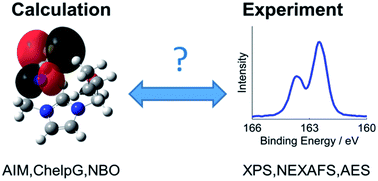当前位置:
X-MOL 学术
›
Faraday Discuss.
›
论文详情
Our official English website, www.x-mol.net, welcomes your
feedback! (Note: you will need to create a separate account there.)
Atomic charges of sulfur in ionic liquids: experiments and calculations
Faraday Discussions ( IF 3.3 ) Pub Date : 2017-06-08 00:00:00 , DOI: 10.1039/c7fd00155j Richard M. Fogarty 1, 2, 3 , Rebecca Rowe 1, 2, 3 , Richard P. Matthews 1, 2, 3 , Matthew T. Clough 1, 2, 3 , Claire R. Ashworth 1, 2, 3 , Agnieszka Brandt 2, 3, 4 , Paul J. Corbett 2, 3, 4 , Robert G. Palgrave 1, 3, 5 , Emily F. Smith 3, 6, 7 , Richard A. Bourne 3, 6, 8, 9, 10 , Thomas W. Chamberlain 3, 6, 9, 10 , Paul B. J. Thompson 11, 12, 13, 14, 15 , Patricia A. Hunt 1, 2, 3 , Kevin R. J. Lovelock 1, 3, 16
Faraday Discussions ( IF 3.3 ) Pub Date : 2017-06-08 00:00:00 , DOI: 10.1039/c7fd00155j Richard M. Fogarty 1, 2, 3 , Rebecca Rowe 1, 2, 3 , Richard P. Matthews 1, 2, 3 , Matthew T. Clough 1, 2, 3 , Claire R. Ashworth 1, 2, 3 , Agnieszka Brandt 2, 3, 4 , Paul J. Corbett 2, 3, 4 , Robert G. Palgrave 1, 3, 5 , Emily F. Smith 3, 6, 7 , Richard A. Bourne 3, 6, 8, 9, 10 , Thomas W. Chamberlain 3, 6, 9, 10 , Paul B. J. Thompson 11, 12, 13, 14, 15 , Patricia A. Hunt 1, 2, 3 , Kevin R. J. Lovelock 1, 3, 16
Affiliation

|
Experimental near edge X-ray absorption fine structure (NEXAFS) spectra, X-ray photoelectron (XP) spectra and Auger electron spectra are reported for sulfur in ionic liquids (ILs) with a range of chemical structures. These values provide experimental measures of the atomic charge in each IL and enable the evaluation of the suitability of NEXAFS spectroscopy and XPS for probing the relative atomic charge of sulfur. In addition, we use Auger electron spectroscopy to show that when XPS binding energies differ by less than 0.5 eV, conclusions on atomic charge should be treated with caution. Our experimental data provides a benchmark for calculations of the atomic charge of sulfur obtained using different methods. Atomic charges were computed for lone ions and ion pairs, both in the gas phase (GP) and in a solvation model (SMD), with a wide range of ion pair conformers considered. Three methods were used to compute the atomic charges: charges from the electrostatic potential using a grid based method (ChelpG), natural bond orbital (NBO) population analysis and Bader’s atoms in molecules (AIM) approach. By comparing the experimental and calculated measures of the atomic charge of sulfur, we provide an order for the sulfur atoms, ranging from the most negative to the most positive atomic charge. Furthermore, we show that both ChelpG and NBO are reasonable methods for calculating the atomic charge of sulfur in ILs, based on the agreement with both the XPS and NEXAFS spectroscopy results. However, the atomic charges of sulfur derived from ChelpG are found to display significant, non-physical conformational dependence. Only small differences in individual atomic charge of sulfur were observed between lone ion (GP) and ion pair IL(SMD) model systems, indicating that ion–ion interactions do not strongly influence individual atomic charges.
中文翻译:

离子液体中硫的原子电荷:实验和计算
报告了离子液体(ILs)中具有一系列化学结构的硫的实验近边缘X射线吸收精细结构(NEXAFS)光谱,X射线光电子(XP)光谱和俄歇电子光谱。这些值提供了每个IL中原子电荷的实验测量值,并能够评估NEXAFS光谱学和XPS用于探测硫的相对原子电荷的适用性。此外,我们使用俄歇电子能谱法表明,当XPS结合能相差小于0.5 eV时,对原子电荷的结论应谨慎对待。我们的实验数据为使用不同方法获得的硫原子电荷的计算提供了基准。在气相(GP)和溶剂化模型(SMD)中,计算了孤离子和离子对的原子电荷,具有广泛的离子对构象异构体。三种方法用于计算原子电荷:使用基于网格的方法(ChelpG)来自静电势的电荷,自然键轨道(NBO)总体分析和分子中的Bader原子(AIM)方法。通过比较硫原子电荷的实验和计算方法,我们为硫原子提供了一个顺序,范围从最负的原子到最正的原子。此外,基于与XPS和NEXAFS光谱结果的一致性,我们证明ChelpG和NBO都是计算ILs中硫原子电荷的合理方法。但是,发现源自ChelpG的硫原子电荷显示出显着的非物理构象依赖性。
更新日期:2017-12-15
中文翻译:

离子液体中硫的原子电荷:实验和计算
报告了离子液体(ILs)中具有一系列化学结构的硫的实验近边缘X射线吸收精细结构(NEXAFS)光谱,X射线光电子(XP)光谱和俄歇电子光谱。这些值提供了每个IL中原子电荷的实验测量值,并能够评估NEXAFS光谱学和XPS用于探测硫的相对原子电荷的适用性。此外,我们使用俄歇电子能谱法表明,当XPS结合能相差小于0.5 eV时,对原子电荷的结论应谨慎对待。我们的实验数据为使用不同方法获得的硫原子电荷的计算提供了基准。在气相(GP)和溶剂化模型(SMD)中,计算了孤离子和离子对的原子电荷,具有广泛的离子对构象异构体。三种方法用于计算原子电荷:使用基于网格的方法(ChelpG)来自静电势的电荷,自然键轨道(NBO)总体分析和分子中的Bader原子(AIM)方法。通过比较硫原子电荷的实验和计算方法,我们为硫原子提供了一个顺序,范围从最负的原子到最正的原子。此外,基于与XPS和NEXAFS光谱结果的一致性,我们证明ChelpG和NBO都是计算ILs中硫原子电荷的合理方法。但是,发现源自ChelpG的硫原子电荷显示出显着的非物理构象依赖性。









































 京公网安备 11010802027423号
京公网安备 11010802027423号